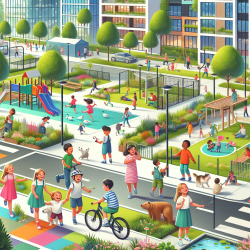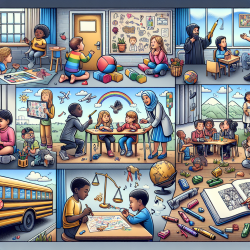The built environment significantly impacts children's quality of life (QoL), a concept that encompasses physical, mental, and social wellbeing. A recent systematic review highlights the relationship between various features of the built environment and children's QoL, offering insights that can guide practitioners in improving their skills and encouraging further research.
The Importance of Green Spaces
Green spaces, such as parks and urban forests, have been consistently linked to improved QoL for children. These areas provide opportunities for physical activity, social interaction, and mental relaxation. Practitioners can advocate for the creation and maintenance of accessible green spaces within communities to enhance children's wellbeing.
Practical Steps for Practitioners:
- Advocate for Green Space Development: Work with urban planners to integrate more green spaces into community designs.
- Promote Active Use: Encourage families to utilize these spaces through community events or programs that highlight the benefits of outdoor activities.
- Evaluate Accessibility: Assess whether existing green spaces are accessible to all children, considering factors like distance and safety.
The Role of Neighborhood Infrastructure
The review found mixed results regarding neighborhood infrastructure such as street connectivity and public transportation. While these elements are crucial for overall urban functionality, their direct impact on children's QoL is less clear. Practitioners should consider how infrastructure supports safe access to recreational areas and schools.
Recommendations for Practitioners:
- Enhance Safety Measures: Collaborate with local authorities to improve pedestrian safety around schools and parks.
- Promote Walkability: Support initiatives that make neighborhoods more walkable, which can encourage physical activity among children.
Perception of Neighborhood Quality
The perception of neighborhood quality, including safety and overall satisfaction, plays a significant role in children's QoL. Positive perceptions can enhance feelings of security and community belonging, which are vital for child development.
Strategies for Improvement:
- Community Engagement: Foster community programs that build trust and cohesion among residents.
- Address Safety Concerns: Work with local law enforcement to address safety issues that may affect children's perception of their neighborhood.
The Need for Further Research
The review underscores the need for more longitudinal studies to establish causal relationships between the built environment and children's QoL. Practitioners are encouraged to participate in or initiate research projects that explore these dynamics further.
This comprehensive approach not only supports individual wellbeing but also informs policies that prioritize children's health in urban planning. As practitioners implement these strategies, they contribute to creating environments where children can thrive physically, mentally, and socially.
To read the original research paper, please follow this link: A systematic review on the relationship between the built environment and children’s quality of life.










